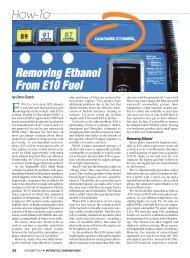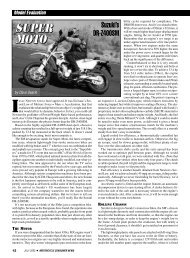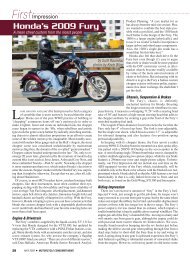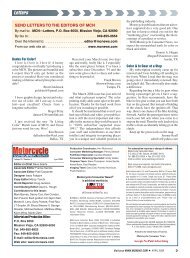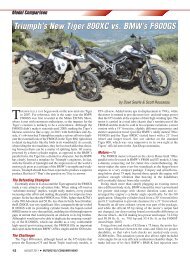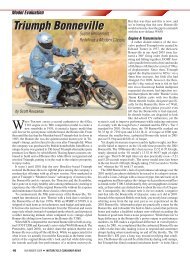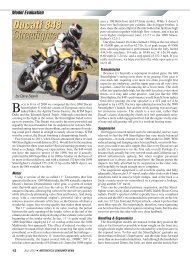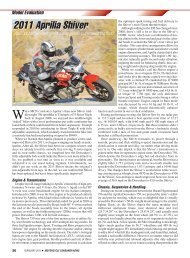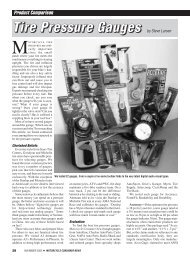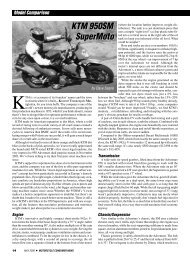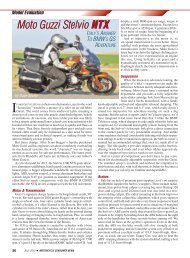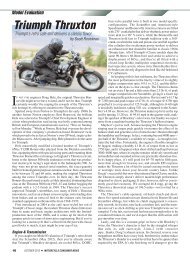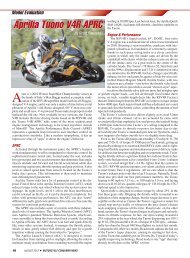BMW K1600GT vs. Kawasaki Concours 14 - Motorcycle Consumer ...
BMW K1600GT vs. Kawasaki Concours 14 - Motorcycle Consumer ...
BMW K1600GT vs. Kawasaki Concours 14 - Motorcycle Consumer ...
You also want an ePaper? Increase the reach of your titles
YUMPU automatically turns print PDFs into web optimized ePapers that Google loves.
ESA, driving modes and grip heat, via the rotation of a single<br />
knob. It takes a little getting used to, but it is very intuitive and<br />
fun to use.<br />
Riding Impression—<strong>K1600GT</strong> 1st; C<strong>14</strong> 2nd<br />
With their powerhouse engines, neutral handling, excellent<br />
wind protection and heated grips, the <strong>K1600GT</strong> and the <strong>Concours</strong><br />
<strong>14</strong> are excellent platforms from which to view the world in<br />
fast motion. The <strong>Concours</strong> <strong>14</strong> offers up the more aggressive feel<br />
with its slightly forward seating position and lower handlebars.<br />
But there are two things that make the GT stand out during<br />
long rides. The first is its Multi-Controller, which gives the rider<br />
plenty of options to fiddle with and occupy time while droning<br />
down a desolate stretch of highway. Even better, though, is the<br />
amazingly raspy exhaust note that emanates from the GT’s dual<br />
mufflers. With less baffling than the GTL, the GT’s mufflers<br />
allow the rider to enjoy the <strong>BMW</strong> six’s exciting exhaust note,<br />
which is more reminiscent of a 12-cylinder Ferrari or Lamborghini<br />
than any German vehicle we’ve ever heard. It makes running<br />
the GT through its gears all the more enjoyable.<br />
The fuel economy delivered by these two is reflective of their<br />
big-block powerplants, and admittedly we aren’t overly confident<br />
that our GT’s fuel mileage is entirely accurate. The problem<br />
lies with the fact that the GT’s fuel filler neck incorporates<br />
a long plastic spigot that extends down into the tank and makes<br />
it difficult to tell when the GT’s 7.0-gal. fuel tank is topped. At<br />
any rate, our GT averaged 42.4 mpg, while the C<strong>14</strong> averaged<br />
37.4 mpg. For more perspective, you can compare these<br />
numbers to the 37.9 mpg that we recorded for the GTL in our<br />
September, 2011, touring comparison and to the 43.3 mpg that<br />
the C<strong>14</strong> averaged on our long-distance Japanese Sport Touring<br />
Shootout in August, 2010.<br />
Attention to Detail—<strong>K1600GT</strong> 1st; C<strong>14</strong> 2nd<br />
If not for two irritating so-called “amenities,” the <strong>Kawasaki</strong> might<br />
have equaled the <strong>BMW</strong> in this category. First is <strong>Kawasaki</strong>’s Intelligent<br />
Proximity Activation Start System (KIPASS), which does away<br />
with the traditional motorcycle key in favor of a remote key fob that<br />
secures the C<strong>14</strong> whenever the fob is more than 5.25' from the motorcycle.<br />
We’re all for security, however, this system has severe drawbacks.<br />
First is that you cannot open the fuel cap or remove the<br />
saddlebags without the fob, as it locks the C<strong>14</strong>’s over-sized ignition<br />
key into the ignition. You can use the accessory key located in the<br />
fob if you should happen to have it with you, but the entire<br />
arrangement is more of a hassle than it’s worth.<br />
The second is the C<strong>14</strong>’s map case. <strong>Kawasaki</strong> engineers<br />
relocated it from the fuel tank to the left side of the<br />
fairing for 2010, but the new case door’s latch mechanism<br />
is far from precise, often requiring serious prying<br />
to get it to release. By the same token, the door can also<br />
require several attempts just to close it securely.<br />
On the plus side, the C<strong>14</strong>’s saddlebags are easy to<br />
open and easy to remove—if you have the key fob—<br />
and its grip heaters offer plenty of warmth for cold riding<br />
days. Also redesigned in 2010, <strong>Kawasaki</strong>’s lower<br />
fairing does a fantastic job of keeping heat off the rider<br />
on warmer days.<br />
The <strong>K1600GT</strong> exudes a high degree of fit and finish<br />
without any noticeable glitches, but it isn’t perfect. Its<br />
annoying fuel tank filler neck is a perfect example.<br />
Another is that while its swing-out air scoops do an<br />
excellent job of ventilating the cockpit in warm weather,<br />
there are no detents to allow the rider to incrementally<br />
adjust their airflow. Adding detents would be a small<br />
improvement that could greatly increase rider comfort.<br />
Scott Rousseau<br />
Value—C<strong>14</strong> 1st; <strong>K1600GT</strong> 2nd;<br />
If you’ve read any of our recent model comparisons that have<br />
included <strong>BMW</strong> motorcycles, then you probably know the challenge<br />
in justifying price <strong>vs</strong>. value of motorcycles in the same<br />
class as a <strong>BMW</strong>. The GT’s base MSRP of $20,900 is nearly $5000<br />
more than the <strong>Kawasaki</strong>, but that doesn’t even scratch the surface<br />
of the GT’s available trim packages.<br />
The base <strong>K1600GT</strong> does include a fixed Xenon headlight with<br />
<strong>BMW</strong>’s dynamic leveling feature, heated seat and heated grips,<br />
cruise control, the multi-function display, on-board computer<br />
and Multi-Controller, the integral ABS package, the E-Gas throttle<br />
with power modes, the electrically adjustable windscreen and<br />
a luggage rack. <strong>BMW</strong>’s Standard Package increases the price to<br />
$23,405 and adds the ESA II electronic suspension adjustment,<br />
GPS-ready wiring and a safety package that includes the Xenon<br />
adaptive headlight, dynamic traction control and tire pressure<br />
monitoring system. Stepping up to the Premium Package for<br />
$24,540 includes all of the above plus a full audio system with a<br />
radio, Sirius satellite radio (with a free one-year subscription),<br />
iPod/USB integration, and an auxiliary input and additional security<br />
features in the form of a power locking system and an alarm.<br />
The 2011 <strong>Kawasaki</strong> <strong>Concours</strong> <strong>14</strong> ABS, as tested here, costs<br />
$15,599. While it lacks all the rider-pampering features of the<br />
GT, it does include two power modes, ABS, traction control, an<br />
electrically adjustable windshield and heated grips.<br />
Simply put, if price is important to you, then the <strong>Kawasaki</strong><br />
<strong>Concours</strong> <strong>14</strong> wins this category, hands down. If the status appeal<br />
of the <strong>BMW</strong> plays a big role in your purchasing decision, the<br />
GT may well justify its hefty premium.<br />
Overall—<strong>K1600GT</strong> 1st; C<strong>14</strong> 2nd<br />
The <strong>Kawasaki</strong> <strong>Concours</strong> <strong>14</strong> ABS is an extremely polished<br />
sport-tourer, with a powerful yet civilized engine, supple suspension<br />
and very good handling character. What it lacks in hightech<br />
gadgetry it makes up for with a purist’s sport-touring ride.<br />
It’s still the best Japanese sport-tourer we’ve ever ridden. The<br />
<strong>BMW</strong> <strong>K1600GT</strong> sets a new bar for the category with its sweetrunning<br />
six-cylinder engine, luxurious comfort and its impressive<br />
array of new technology. For most potential buyers, choosing a<br />
winner will come down to cost. The <strong>Kawasaki</strong> represents the best<br />
value in the over-1000cc sport-touring class today, but the <strong>BMW</strong><br />
is simply at the head of the class. If you want the best, you can get<br />
it in the <strong>BMW</strong>, but it will cost you.<br />
Visit us at WWW.MCNEWS.COM ● FEBRUARY 2012 19



